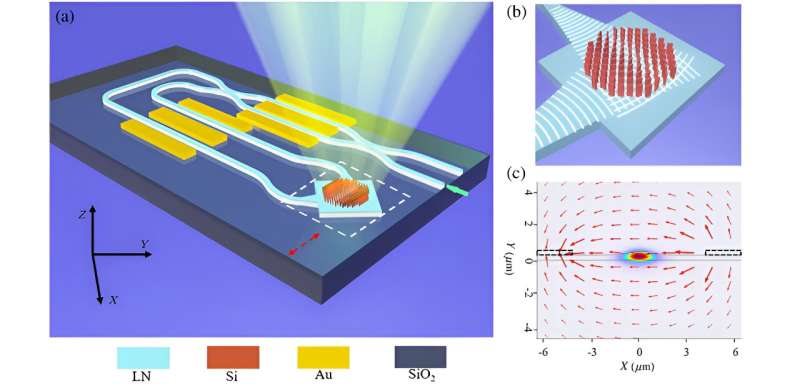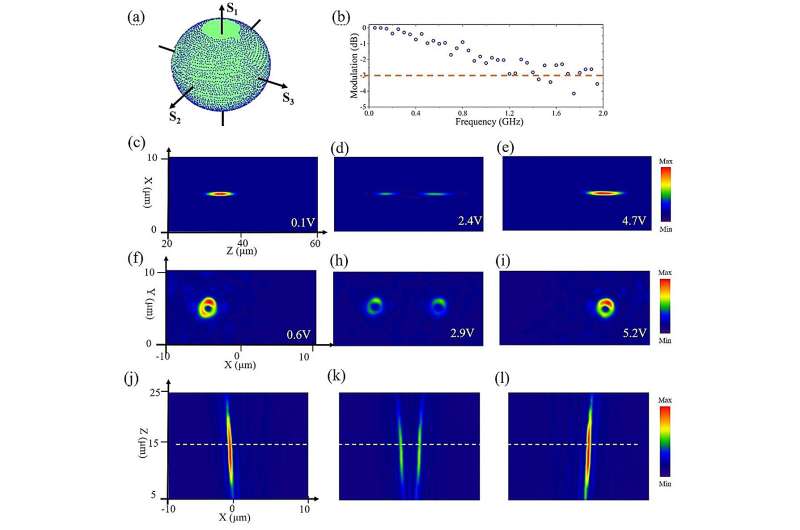This article has been reviewed according to Science X's editorial process and policies. Editors have highlighted the following attributes while ensuring the content's credibility:
fact-checked
peer-reviewed publication
trusted source
proofread
Gigahertz-rate switchable wavefront shaping by LNOI-empowered metasurface

Over the past decade, metasurfaces deploying two-dimensional artificial nanostructures have emerged as a groundbreaking platform to manipulate light across various degrees of freedom. These metasurfaces exhibit significant potential in foundational scientific research and industrial applications.
Compared to the static control of optical fields, dynamic optical field control introduces new control variables in the time domain, allowing real-time beam shaping, spatial light modulation, information processing, and more. Active metasurfaces, capable of manipulating light in both spatial and temporal domains at high speeds, have the potential to open new frontiers in photonic technology, bridging the gap between theoretical physics and practical applications.
Dynamic reconfigurable functionality is key. Despite exploring a range of materials and techniques to enhance metasurface tunability, achieving tunable wavefronts at very high speeds remains a formidable challenge. Fortunately, the recent emergence of lithium-niobate-on-insulator (LNOI) technology provides a promising platform for tunable metasurface in ultra-high speed.
LNOI stands out as a versatile material for photonic integrated circuits (PICs), particularly due to its outstanding electro-optic effect. This technology has significantly advanced PICs, positioning them as a leading platform for future high-speed electro-optic modulation devices.
Recently, a joint research group from East China Normal University and Nanjing University successfully integrated electrodes, metasurface, and LNOI photonic waveguide—all within a PIC device. As reported in Advanced Photonics, they demonstrate an ultra-highspeed wavefront shaping metasurface with the integrated PIC-driven metasurface.

Applying different electric signals to the electrodes, the device exhibits the capability to shape any wavefront in reconfigurable arbitrary polarization states. The researchers showcase the high-speed tunability of various functionalities, including lateral focal position and focal length control, orbital angular momentum (OAM), and Bessel beams.
Through effective combination of the propagation phase and geometric phase of birefringent nanostructures within this waveguide scheme, the tunability of these functionalities can be controlled in arbitrary orthogonal polarizations. The experimental measurements demonstrate the system's operation at modulation speeds of up to 1.4 gigahertz.
The authors emphasize that the current high-speed modulation result is preliminary. The device has potential to enhance the modulation speed to hundreds of gigahertz by optimizing the design of the electrodes, leveraging the electro-optical effect of lithium niobate.
Corresponding author Prof. Lin Li, of the State Key Laboratory of Precision Spectroscopy at East China Normal University, remarks, "The integration of subwavelength metasurfaces and optical waveguides offers a versatile and efficient means to manipulate light across multiple degrees of freedom at high speed in compact PIC devices. This advancement paves the way for potential applications in optical communication, computation, sensing, and imaging."
More information: Haozong Zhong et al, Gigahertz-rate-switchable wavefront shaping through integration of metasurfaces with photonic integrated circuit, Advanced Photonics (2024). DOI: 10.1117/1.AP.6.1.016005
Journal information: Advanced Photonics
Provided by SPIE





















